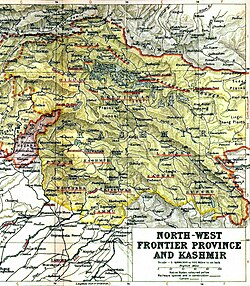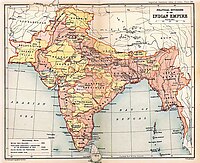Jammu and Kashmir (princely state)
From Wikipedia, the free encyclopedia
| Jammu and Kashmir | ||||||
| Princely State of British India | ||||||
|
||||||
|
||||||
| Map of Kashmir | ||||||
| Historical era | New Imperialism | |||||
| • | Established | 1846 | ||||
| • | Disestablished | 1952 | ||||
| Today part of | China, India and Pakistan | |||||
At the time of the Indian independence, Maharaja Hari Singh, the ruler of the state, preferred to become independent and remain neutral between the successor dominions of India or the Pakistan.[3] However, an uprising in the western districts of the State followed by an attack by raiders from the neighbouring Northwest Frontier Province, allegedly supported by Pakistan, put an end to his plans for independence. On 26 October 1947, the Maharaja signed the Instrument of Accession joining the Dominion of India in return for military aid.[4] The western and northern districts presently known as Azad Kashmir and Gilgit-Baltistan passed to the control of Pakistan.[5]
Contents
Creation
Flag of J&K (1846–1936)
Flag of Maharaja of J&K (1846–1936)
As a vassal of the Sikh Empire, Gulab Singh began expanding his kingdom. He conquered Bhadarwah after a slight resistance. He then annexed Kishtwar after the minister, Wazir Lakhpat, quarrelled with the ruler and sought the assistance of Gulab Singh. The Raja of Kishtwar surrendered without fighting when Gulab Singh's forces arrived. The conquest of Kishtwar meant that Singh had gained control of two of the roads which led into Ladakh, which then led to the conquest of that territory. Although there were huge difficulties due to the mountains and glaciers, Gulab Singh's Dogra troop under his general Zorawar Singh Kahluria conquered the whole of Ladakh in two campaigns.[8]
A few years later, in 1840, Zorawar Singh invaded Baltistan, captured the Raja of Skardu, who had sided with the Ladakhis, and annexed his country to Gulab Singh's kingdom. In 1841 Zorawar Singh invaded Tibet, but perished with nearly his entire army in the harsh winter. Whether it was policy or whether it was accident, by 1840 Gulab Singh had encircled Kashmir.[8]
In the winter of 1845, the First Anglo-Sikh War broke out. Gulab Singh remained neutral until the Battle of Sobraon in 1846, when he appeared as a useful mediator and the trusted adviser of Sir Henry Lawrence. The war was ended by two treaties. In the Treaty of Lahore, the Sikh Empire ceded territory to the East India Company in lieu of part of a large indemnity; this territory included the hill country between the rivers Beas and Indus.
The EIC had incurred large expenses in the Anglo-Sikh War. Sir Henry Lawrence counselled the Viceroy, Lord Hardinge, to recover these outlays by selling Kashmir to Gulab Singh. Thus, in the Treaty of Amritsar, for 7.5 million Nanakshahee Rupees the EIC made over to Gulab Singh all the hilly or mountainous country "situated to the westward of the river Indus and eastward of the river Ravi", and recognized him as Maharaja of Kashmir and Jammu.[8] The new state covered an area of 80,900 square miles (210,000 km2).[9] Later, the regions of Hunza, Nagar, and Gilgit were added to the state.
Sikh chief minister Lal Singh asked the governor of Kashmir, Imam-Uddin, to resist occupation by Gulab Singh's Dogras. British forces were sent to support Gulab Singh, and Immad-Uddin submitted. He also produced the letters from Lal Singh directing him to oppose Gulab Singh. For this treachery, Lal Singh faced the wrath of the British Empire. Lal Singh was removed from his post and also banished from the Punjab.[10]
Administration
Maharaja
| S.no | Name | Reign |
|---|---|---|
| 1. | Gulab Singh | 1846–1857 |
| 2. | Ranbir Singh | 1857–1885 |
| 3. | Pratap Singh of Jammu and Kashmir | 1885–1925 |
| 4. | Hari Singh | 1925–1948 |
| 5. | Karan Singh (Prince Regent) | 1948-1952 |
Prime ministers
| # | Name | Took Office | Left Office |
|---|---|---|---|
| 1 | Raja Hari Singh | 1925 | 1927 |
| 2 | Sir Albion Banerjee | January, 1927 | March, 1929 |
| 3 | G.E.C. Wakefield | 1929 | 1931 |
| 4 | 1933 | ||
| 5 | Elliot James Dowell Colvin | 1933 | 1936 |
| 6 | Sir Barjor J. Dalal | 1936 | 1936 |
| 7 | Sir N. Gopalaswami Ayyangar | 1936 | July, 1943 |
| 8 | Kailas Narain Haksar | July, 1943 | February, 1944 |
| 9 | Sir Benegal Narsing Rau | February, 1944 | 28 June 1945 |
| 10 | Ram Chandra Kak | 28 June 1945 | 11 August 1947 |
| 11 | Janak Singh Katoch | 11 August 1947 | 15 October 1947 |
Expansion
Not long afterwards the Rajah of Hunza attacked Gilgit. Nathu Shah on behalf of Gulab Singh responded by leading a force of Dogras into the Hunza valley. He and his force were destroyed, and Gilgit fort fell into the hands of the Rajah of Hunza, along with Punial, Yasin, and Darel. Gulab then sent two columns, one from Astore and one from Baltistan, and after some fighting recovered Gilgit. In 1852, the Dogras at Gilgit were annihilated by Gaur Rahman of Yasin, and for eight years the Indus formed the northern boundary of the Maharaja's territories.[11]Gulab Singh died in 1857. His successor, Ranbir Singh, loyally sided with the British in the Indian Rebellion of 1857. When Kashmir had recovered from the strain of the Rebellion. Ranbir determined to recover Gilgit and to expand the frontier. In 1860 a force under Devi Singh crossed the Indus, and advanced on Gaur Rahman's fortress at Gilgit. Gaur Rahman had died just before the arrival of the Dogras, and Gilgit was taken.[11] Gilgit was not the last frontier, however. Ranbir attempted to conquer Yasin and Punial, but failed for lack of funds. To make a secure frontier, he withdrew his forces to Gilgit. Kashmir and Jammu held Gilgit until the partition of India in 1947.[12]
Ranbir Singh, although tolerant of other creeds, lacked his father's strong will and determination, and his control over the State officials was weak. The latter part of his life was darkened by the dreadful famine in Kashmir, 1877-9. In September 1885, he was succeeded by his eldest son, Pratap Singh.[11]
Pratap Singh defeated the ruler of Chitral in 1891, and forced Hunza and Nagar to accept the suzerainty of Kashmir and Jammu state.[13]
Geography
1909 map showing Kashmir
Steeper parts of the Himalayas lead to Astore and Baltistan on the north and to Ladakh on the east, a tract drained by the river Indus. To the north-wes, lies Gilgit, west and north of the Indus, the whole area shadowed by a wall of giant mountains which run east from the Kilik or Mintaka passes of the Hindu Kush, leading to the Pamirs and the Chinese dominions past Rakaposhi (25,561 ft), along the Muztagh range past K2 (Godwin Austen, 28,265 feet), Gasherbrum and Masherbrum (28,100 and 28,561 feet (8,705 m) respectively) to the Karakoram range which merges in the Kunlun Mountains. Westward of the northern angle above Hunza and Nagar, the maze of mountains and glaciers trends a little south of east along the Hindu Kush range bordering Chitral, and so on into the limits of Kafiristan and Afghan territory.[9]
Transport
There used to be a route from Kohala to Leh; it was possible to travel from Rawalpindi via Kohala and over the Kohala Bridge into Kashmir. The route from Kohala to Srinagar was a cart-road 132 miles (212 km) in length. From Kohala to Baramulla the road was close to the River Jhelum. At Muzaffarabad the Kishenganga River joins the Jhelum and at this point the road from Abbottabad and Garhi Habibullah meet the Kashmir route. The road carried heavy traffic and required expensive maintenance by the authorities to repair.[14]Flooding
In 1893, after 52 hours of continuous rain, very serious flooding took place in the Jhelum valley and much damage was done to Srinagar. The floods of 1903 were much more severe, a great disaster.[15]End of the princely state
In 1947, Britain gave up its rule of India. The Indian Independence Act divided British India into two independent states, the Dominion of Pakistan and Dominion of India. According to the Act, "the suzerainty of His Majesty over the Indian States lapses, and with it, all treaties and agreements in force at the date of the passing of this Act between His Majesty and the rulers of Indian States."[16] So each of the princely states was now free to join India or Pakistan or to remain independent. Most of the princes acceded to one or the other of the two nations.Jammu and Kashmir had a Muslim majority but was ruled by a Hindu Rajput Raja. On 2 October 1947, the Working Committee of the National Conference met under Sheikh Mohammad Abdullah's presidency and took the decision to support the accession of the State to India. The decision of the Working Committee was conveyed to Indian leader Nehru by another Kashmiri, Dwarka Nath Kachroo, the Secretary General of the All India States Peoples' Conference, who was attended the Working Committee meeting as an observer.[citation needed]
Maharaja Hari Singh wanted his state to remain independent, joining neither Pakistan nor India. For this reason, he offered a standstill agreement (to maintain the status quo) to both India and Pakistan. India refused the offer but Pakistan accepted it. The Maharaja was advised by Mehr Chand Mahajan, who later became his Prime Minister, that a landlocked country such as Kashmir would be soon engulfed by foreign powers such as the USSR or China.[13]
The Gilgit Scouts staged a rebellion in the Northern Areas under British command. As a result, this region became effectively a part of Pakistan (and has since been administered by Pakistan). Subsequently Kabaili tribesmen (Mehsuds and Afridis) from the Northwest Frontier Province invaded Kashmir proper. The Pakistan Army's British chiefs, Sir Frank Messervy and Douglas Gracey, refused to involve the armed forces.
With independence no longer an option, the Maharaja turned to India, requesting troops to safeguard Kashmir. Although Nehru was ready to send troops, Governor-General Mountbatten advised the Maharaja to accede to India before India would send its troops. The Kabaili tribesmen spread into Kashmir. So the Maharaja signed the Instrument of Accession to the Dominion of India on 26 October 1947.
Sheikh Mohammad Abdullah had already reached Delhi on 25 October to persuade Nehru to lose no time in accepting the accession and dispatching Indian troops to the State.[17]
The Instrument was accepted by the Governor-General the next day, 27 October. With the signature of the Maharaja and the acceptance by the Governor-General, the princely state of Jammu and Kashmir became a part of the Dominion of India. Indian troops landed at Srinagar airport in Kashmir on 27 October and secured the airport before proceeding to evict the invaders from the Kashmir Valley.
The princely state of Kashmir and Jammu, thus came under Indian suzerainty on 27 October 1947, with a portion of it having passed to Pakistan's control. The Maharaja appointed Sheikh Abdullah as the Prime Minister and, in 1948, appointed his son Karan Singh as the Prince Regent to act on his behalf. Jammu and Kashmir operated as a princely state under Indian control till 1952, when the Constitution of India came into effect, abolishing monarchies. Karan Singh then accepted the post of Sadar-i-Riyasat (constitutional Head of State).






No comments:
Post a Comment